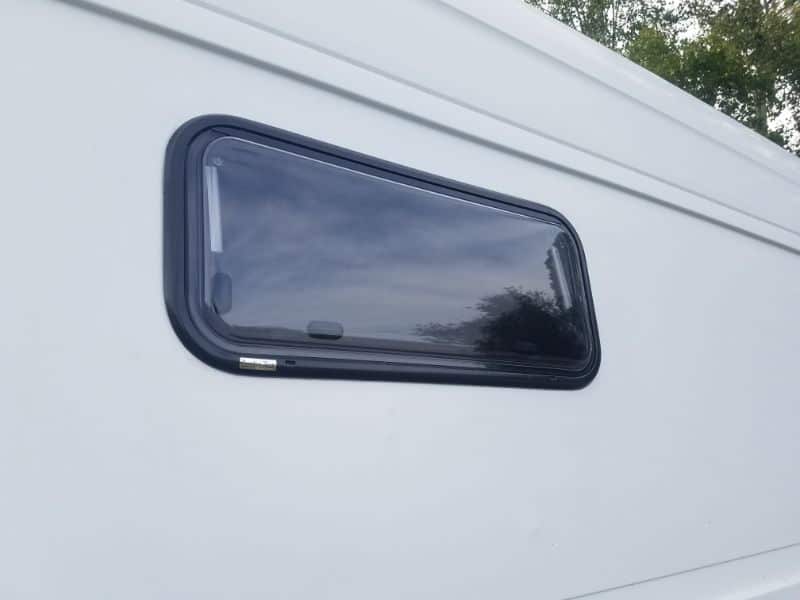So, you’re thinking about building a van, or maybe you are part-way through the process. Either way, you will debate what size of window you want or which layout optimizes storage space. I’ve been going through my van-building process with my husband for the last two years, and it didn’t take long before we had built a list of van build mistakes that we would do differently next time.
(For reference, we own a 2008 Mercedes Sprinter with a 170-inch wheelbase and high roof.)
5 Van Build Keeps!
***
Murphy Bed – Keep

I was skeptical of this one when my husband first suggested it. I had seen many van-build layouts and thought that we would lose out on a lot of storage and that having the bed up against the wall during the day would feel awkward. Instead, it made space to have an actual living room. The bed folds on top of an L-shaped bench, which can comfortably seat 3-4 people. We have plenty of storage under the bench, and it creates a clear divide between the day and night. Once we start the day, our bed is made and folded up, and as soon as it’s down, it means that the end of the day is here. We put in the Easy DIY Murphy Bed off of Amazon, which has all of the metal parts, and requires you to build the actual bed frame.
Rear Gear Storage Compartment – Keep
We have a space in the back where we can put our gear. This keeps our wet skis or stinky running packs and shoes away from everything else. Since the mess is segregated from the rest, installing a drainage system and giving the moisture a place to go is also easier. It also means less space that we need to heat.
Diesel Air Heater – Keep
Again, the heater was essential since we planned on this van taking us through many cold nights. We got a Planar Diesel Air Heater Autoterm 4D. We live in Montana, and the winters here can have some brutal nights, like -40 degrees Fahrenheit type vicious. In most places, you don’t need as robust of a heater. The installation process was fairly simple. We connected the heater to the back of the passenger seat and cut a hole in the bottom of the van in order to run another fuel line and connected it directly to our fuel tank. This heater runs off of diesel, which is the same as our van, which is a 3.0 CRD. It keeps it simple in that we don’t have to worry about keeping many different types of fuel in the van for each thing. The heater is high-powered and produces dry heat.
The one remark I will make is that even though the heater does not take much diesel, we still have to be mindful of how much diesel is in the tank at the beginning of the night so we don’t accidentally run out. Do not get stranded!
Ceiling Fans – Keep

Airflow is critical in a van. We bought two MaxAir 6200 fans and installed one towards the back, above our heads when we sleep, and another in the front by the kitchen. They are easy to pop up and connect to the electrical system seamlessly. It keeps airflow moving, and the circulation is lovely when you have both going. The fan above our heads at night keeps condensation from collecting too much and keeps us cool in the middle of summer.
Dometic Fridge – Keep
The age-old question: a fridge or a cooler? We toyed around with the idea of just getting a nice, large Yeti cooler to start. We knew that we would eventually want a proper fridge, so we decided to spring for one immediately. We got a Dometic CFX 75DZ fridge, which comes in at about $1,250; a price out of my comfort zone. It is the size of a giant Yeti cooler with two compartments. One is a fridge, while the other is a freezer. Having that freezer element, while not necessary, is a luxury that I have enjoyed. Ice cream in the middle of the desert makes me feel quite smug, if I do say so myself. We built a small platform for it and installed it against the foot of the bed. It sticks out slightly when opening the sliding door to the van, but has yet to make the space feel cramped.
5 Van Build Mistakes
***
Foam Insulation – Too Complicated

We designed and built the van to be comfortable during the winter and allow us to go on ski trips. We used a combination of 1 inch rigid foam insulation, Thinsulate, and spray foam for areas we couldn’t reach otherwise. We have spent countless hours putting in the insulation; overall, it has worked. However, we both decided that we over-complicated the process. If we had just picked one type of insulation and stayed with it instead of trying to optimize each type of insulation for each spot in the van, the whole process would have been easier and faster.
No Toilet – Bad Idea
Initially, we did not think about adding a toilet to the build, assuming that if needed, we could pull into a gas station or camping, and the outdoors would be fine. While this is true most of the time, we must spend the occasional night in a parking lot or covertly camping in the city. I get up to use the bathroom most nights, and even if we are at a campground, I usually wake up Eric when I open the sliding van door. Even if it’s basic and not used often, thinking about a toilet is highly recommended. I can’t recommend it yet, since we have yet to purchase one but we are currently looking at a bucket toilet from REI, or my husband has said we could always use wag bags in a pinch. We will see.
>>> READ MORE: Should You Travel in a Camper Without a Bathroom?
DIY Harnesses – Too Difficult
The entire van build was DIY, and that included the electrical work. I want to start by saying there were no fires, and it works! /We would do our own electricity again. If we were to do it again, we would buy prebuilt wires from Amazon with connectors already crimped and attached. We got each part and assembled it piece by piece, which was far more time-consuming than needed.
15-Gallon Water Jugs – Too Big!

One of our goals was to go off-grid for at least two weeks at a time. The thought was that we would need as much water as we could fit, which is not wrong. Let me tell you, 15-gallon jugs are too much. Not that you can’t go through 15 gallons of water. But the water jugs are unwieldy and hard to maneuver. Plus, they are hard to fit in the van well. Our original plan was to put two of these jugs at the front, in the cabinet by our sliding door. Before we installed them, we knew we would have to get rid of the one we were going to use for gray water and replace it with a 5-gallon jug. We first tried to install the second one on its side since it was too tall, but filling it became too much of a pain and we soon changed that one out as well. The 5-gallon jugs are far more easily maneuverable, and you can just put a couple next to each other for the same overall quantity.
Window – Too Small!

Lastly, the window that we bought. It is an Arctic Tern window that is 300mm x 500mm. So far, I have liked the company that we got it from. The installation was easy and double-paned, so it doesn’t let out too much heat. I mainly wish that we had gotten a bigger one, and put it in front of the stove at the front of the van. We put it further back, where our L-shaped bench is, which is nice while sitting, but leaves something to be desired while cooking. It is longer than some options but ended up smaller than we envisioned when we bought it. My recommendation is to make sure you measure out everything exactly for the van. You never know what a difference a couple of inches will make here or there in the build.
>>> READ MORE: Step-By-Step Guide to Converting My Van on a Budget
Overall, I love our van, despite some of our van build mistakes. It has been a long journey, and the van took us more time than we initially thought to build it. The van is also a source of pride, though. It is something that we created ourselves and has been a constant learning experience – although it can be a love-hate relationship sometimes. I wish you all the best of luck with your van builds!
Robin and her husband Eric have been building out their 2008 Mercedes Sprinter and love to take it to new mountains in the winter. She loves to ski, and they have geared the van for just that. You can usually find her at a local coffee shop or library working on her next novel when she's not in the mountains.
-
Robin Ferrierhttps://changingears.com/author/robin-ferrier/
-
Robin Ferrierhttps://changingears.com/author/robin-ferrier/
-
Robin Ferrierhttps://changingears.com/author/robin-ferrier/










